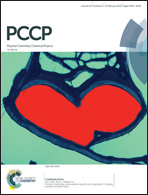Complexation of halide ions to tyrosine: role of non-covalent interactions evidenced by IRMPD spectroscopy†
Abstract
The binding motifs in the halide adducts with tyrosine ([Tyr + X]−, X = Cl, Br, I) have been investigated and compared with the analogues with 3-nitrotyrosine (nitroTyr), a biomarker of protein nitration, in a solvent-free environment by mass-selected infrared multiple photon dissociation (IRMPD) spectroscopy over two IR frequency ranges, namely 950–1950 and 2800–3700 cm−1. Extensive quantum chemical calculations at B3LYP, B3LYP-D3 and MP2 levels of theory have been performed using the 6-311++G(d,p) basis set to determine the geometry, relative energy and vibrational properties of likely isomers and interpret the measured spectra. A diagnostic carbonyl stretching band at ∼1720 cm−1 from the intact carboxylic group characterizes the IRMPD spectra of both [Tyr + X]− and [nitroTyr + X]−, revealing that the canonical isomers (maintaining intact amino and carboxylic functions) are the prevalent structures. The spectroscopic evidence reveals the presence of multiple non-covalent forms. The halide complexes of tyrosine conform to a mixture of plane and phenol isomers. The contribution of phenol-bound isomers is sensitive to anion size, increasing from chloride to iodide, consistent with the decreasing basicity of the halide, with relative amounts depending on the relative energies of the respective structures. The stability of the most favorable phenol isomer with respect to the reference plane geometry is in fact 1.3, −2.1, −6.8 kJ mol−1, for X = Cl, Br, I, respectively. The change in π-acidity by ring nitration also stabilizes anion–π interactions yielding ring isomers for [nitroTyr + X]−, where the anion is placed above the face of the aromatic ring.



 Please wait while we load your content...
Please wait while we load your content...